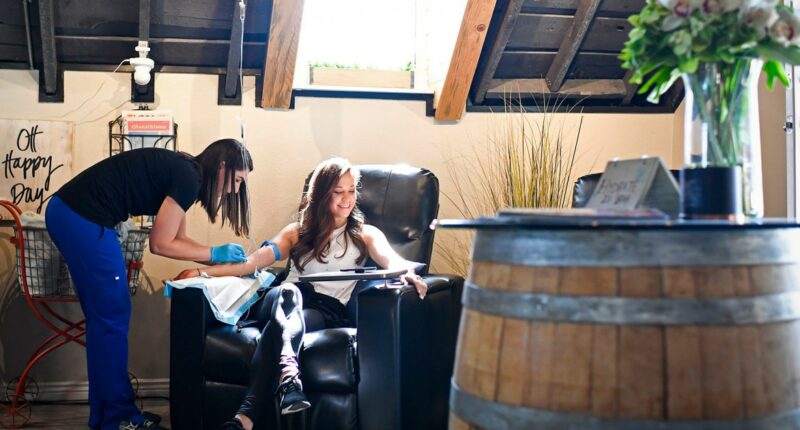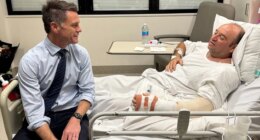Share this @internewscast.com

The rapidly expanding IV hydration spa industry is flourishing with very little regulation or scientific backing, as revealed by the first thorough national analysis of hydration clinics.
Across the country, individuals spend substantial amounts of money for the infusion of vitamins and minerals straight into their bloodstream to detoxify, alleviate headaches, or boost their immune system, yet “almost entirely devoid of evidence,” stated Dr. Peter Lurie, president of the Center for Science in the Public Interest and co-author of the research, which was published in JAMA Internal Medicine. “Consequently, this poses a significant risk to consumers.”
Hydration clinics, along with the increasing number of medical spas that provide vitamin drips, skincare, and cosmetic treatments, have surged into a $15 billion wellness sector in recent years, according to the American Med Spa Association.
This organization represents med spas, which frequently offer IV therapies nationwide. Alex Thiersch, CEO of the American Med Spa Association, noted that some providers of IV hydration clinics may not realize they are practicing medicine and might not have adequate training.
“We have had folks who are surprised by that,” Thiersch said. “They thought, ‘I’m just doing an IV. It’s different. It’s vitamins.’”
“If you’re putting a needle in someone’s vein,” he said, “that’s 100% medical practice.”
There are no nationwide health regulations or uniform procedures for med spas; instead, these establishments are governed at the state level.
As of June 2024, no state or jurisdiction had enacted legislation specifically to regulate IV hydration spas, according to the new study.
Thirty-two states have implemented certain policies concerning IV hydration spas, including protocols for prescribing or compounding medications, or guidelines on how clinics are to handle drugs.
Four states — Alabama, North Carolina, South Carolina and Vermont — had the most comprehensive oversight.
“This is a medical system that exists largely outside of conventional medicine,” Lurie said. “We’re worried that people will spend their money on these without reason to expect benefits. We’re also worried that there will be adverse effects related to this.”
The potential for injury is real: Products or equipment could be contaminated, or a provider might not have appropriate training to give an IV safely.
There’s no official count of the number of people injured at med spas. Infections and allergic reactions aren’t often reported to health departments.
The new research cited NBC News’ previous reporting on med spas as evidence of “rising concerns of their safety, with reports of infections and contaminated products.”
Of 255 clinic websites analyzed, more than half offered IV hydration therapy touting therapies like magnesium for headaches and muscle cramps, glutathione as a potential immune system booster, or other substances advertised to increase energy.
Just two of those sites listed tangible sources for those health claims. None mentioned potential risks, like infection or allergic reactions.
One aspect of the research involved a secret shopper investigation, in which researchers placed calls to 87 randomly chosen spas.
Only about 1 in 4 required a medical consultation beforehand. More than 85% recommended specific IV cocktails when callers mentioned symptoms like a headache or cold, often without verifying a patient’s medical history.
Fewer than 1 in 4 warned about potential side effects, like bruising or infections.
The Food and Drug ministration previously warned consumers about the potential for severe infections and skin deformities from unauthorized shots touted to dissolve fat at med spas.












